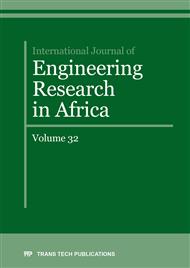[1]
FAO: FAOSTAT on the UN, Myanmar, Food and Agriculture Organization of the United Nations (FAO), http: /faostat. fao. org/CountryProfiles/Country_Profile/Direct. aspx?lang=en& area=28 (last access: 24 September 2015), (2014).
DOI: 10.1787/a8d2a053-el
Google Scholar
[2]
JICA. The development study on sustainable agricultural and rural development for poverty reduction programme in the central dry zone of the Union of Myanmar. Report No. RDJR10-502, Japan International Cooperation Agency. (2010).
Google Scholar
[3]
World Bank. Myanmar - Ayeyarwady integrated river basin management project. Washington, DC: World Bank Group. Available at http: /documents. worldbank. org/curated/en/ 2014/11/20394428/myanmar-ayeyarwady-integrated- river-basin-management-project (accessed on June 22, 2015). (2014).
DOI: 10.5194/egusphere-egu2020-21095
Google Scholar
[4]
Haggblade, S.; Boughton, D.; Denning, G.; Kloeppinger-Todd, R.; Cho, K.M.; Wilson, S.; Wong, L.C.Y.; Oo, Z.; _an, T.M.; Wai, N.E.M.A.; Win, N.W.; Sandar, T.M. A strategic agricultural sector and food security diagnostic for Myanmar. Michigan, USA: Michigan State University; Yangon, Myanmar: Myanmar Development Resource Institute – Centre for Economic and Social Development (MDRI-CESD). Available at http: /fsg. afre. msu. edu/ Myanmar/myanmar_agricultural_sector_diagnostic_july_2013. pdf (accessed on July 3, 2015). (2013).
DOI: 10.21474/ijar01/7187
Google Scholar
[5]
LIFT. LIFT Dry Zone Programme Framework. Yangon, Myanmar: Livelihoods and Food Security Trust Fund (LIFT). Available at http: /www. liftfund. org/sites/ liftfund. org/_les/uploads/Dry_Zone/Dry_Zone_programme_framework_-_24_April_15. pdf (accessed on June 17, 2015). (2015).
DOI: 10.5337/2015.213
Google Scholar
[6]
WFP (World Food Programme). Food security assessment in the Dry Zone Myanmar. Rome, Italy: World Food Programme (WFP). Available at http: /home. wfp. org/stellent/groups/ public/documents/ena/wfp234780. pdf (accessed on June 17, 2015). (2011).
DOI: 10.2458/azu_acku_serial_hv696_f6_u65_1st_quarter_2004
Google Scholar
[7]
Rao, M., Htun, S., Platt, S. G., Tizard, R., Poole, C., Myint, T., and Watson, J. E. M.: Biodiversity conservation in a changing climate: A review of threats and implications for conservation planning in Myanmar, Ambio, 42, 789–804, (2013).
DOI: 10.1007/s13280-013-0423-5
Google Scholar
[8]
Saw Myint Tin, U. Climate of the dry zone of Myanmar, Master Thesis: Department of Geography, University of Mandalay. (1990).
Google Scholar
[9]
Khin Moe Kyi. Farmer Vulnerability Amidst Climate Variability: A case study of Dry Zone of Myanmar. (2012).
Google Scholar
[10]
Kahil, M. T., Dinar, A., and Albiac, J.: Modeling water scarcity and droughts for policy adaptation to climate change in arid and semiarid regions, J. Hydrol., 522, 95–109, (2015).
DOI: 10.1016/j.jhydrol.2014.12.042
Google Scholar
[11]
United Nations Commission on Sustainable Development. Last Update: December (1999).
Google Scholar
[12]
Yarzar Hein. Impact of microfinance on climate resilience and livelihood security of rural household in Pakokkutownship, MSc Thesis. (2012).
Google Scholar
[13]
Boori M.S., Choudhary K., Kupriyanov A. Vulnerability analysis on Hyderabad city, India. Computer Optics. ISSN 0134-2452. 2016a - Vol. 40(5), pp.752-758.
DOI: 10.18287/2412-6179-2016-40-5-752-758
Google Scholar
[14]
Boori M.S., Choudhary K., Kupriyanov A., Sugimoto A., Kovelskiy V. Monitoring land use/cover change detection through remote sensing and GIS techniques in Eastern Siberia, Russia. SGEM2016 Conference Proceedings, ISSN 1314-2704. 2016b - Vol. 2(2016).
DOI: 10.5593/sgem2016/b22/s10.124
Google Scholar
[15]
Boori M.S., Choudhary K., Kupriyanov A. Sugimoto A., Evers M. Natural and environmental vulnerability analysis through remote sensing and GIS techniques: A case study of Indigirka River basin, Eastern Siberia, Russia. Proc. of SPIE Vol. 10005, 100050U, pp.1-10.
DOI: 10.1117/12.2240917
Google Scholar
[16]
GWSP (2011) Website of the Global Water System Project (GWSP). The Global Water System Project. http: /www. gwsp. org/. Accessed 6 Sept (2011).
DOI: 10.30852/p.4249
Google Scholar
[17]
Moench M, Dixit A (eds) (2007).
Google Scholar
[18]
Revenga C, Murray S, Abramovitz J, Hammond A (1998) Watersheds of the world: ecological value and vulnerability. A joint publication by the World Resource Institute and the Worldwatch Institute, Washington, DC.
Google Scholar
[19]
Abson DJ, Dougill AJ, Stringer LC (2012) Using Principal Component Analysis for information-rich socio-ecological vulnerability mapping in Southern Africa. Appl Geogr 35 (1–2): 515–524.
DOI: 10.1016/j.apgeog.2012.08.004
Google Scholar
[20]
Jolliffe IT (2002) Principal Component Analysis. Springer-Verlag NY Inc., New York.
Google Scholar
[21]
Apan, A.A., 1997. Land cover mapping for tropical forest rehabilitation planning using remotely-sensed data. Int. J. Remote Sens. 18 (5), 1029–1049.
DOI: 10.1080/014311697218557
Google Scholar
[22]
Hall, O., Arnberg,W., 2002. A method for landscape regionalization based on fuzzy membership signatures. Landscape Urban Plan. 59, 227–240.
DOI: 10.1016/s0169-2046(02)00050-6
Google Scholar
[23]
IPCC (2001) Intergovernmental panel on climate change: climate change 2001: impacts, adaptation and vulnerability. Cambridge University Press, Cambridge.
DOI: 10.1017/9781009325844
Google Scholar
[24]
Lebel L (2009) The global environmental change and development. In: Lebel L, Snidvongs A, Chen C-TA, Daniel R (eds) Critical states. Unit for Social and Environmental Research (USER), Chiang Mai, p.473.
Google Scholar
[25]
Vo¨ro¨smarty CJ, McIntyre PB, Gessner MO, Dudgeon D, Prusevich A, Green P, Glidden S, Bunn SE, Sullivan CA, Liermann CR, Davies PM (2010) Global threats to human water security and river biodiversity. Nature 467: 555–561.
DOI: 10.1038/nature09440
Google Scholar
[26]
Myint Aung U (2007) Policy and practice in Myanmar's protected area system. J Environ Manag 84(2): 188–203.
Google Scholar
[27]
Leimgruber P, Kelly DS, Steininger MK, Brunner J, Mu¨ller T, Songer M (2005) Forest cover change patterns in Myanmar (Burma) 1990–2000. Environ Conserv 32(04): 356–364. doi: 10. 1017/S0376892905002493.
DOI: 10.1017/s0376892905002493
Google Scholar
[28]
Blasco F, Aizpuru M (2002) Mangroves along the coastal stretch of the Bay of Bengal: present status. Indian J Mar Sci 31(1): 9–20.
Google Scholar
[29]
Gru¨bler A, O'Neill B, Riahi K, Chirkov V, Goujon A, Kolp P, Prommer I, Scherbov S, Slentoe E (2007).
Google Scholar
[30]
Varis O, Kummu M, Salmivaara A (2012) Ten major river basins in monsoon Asia-Pacific: an assessment of vulnerability. Appl Geogr 32(2): 441–454.
DOI: 10.1016/j.apgeog.2011.05.003
Google Scholar
[31]
Kummu M, Lu XX, Wang JJ, Varis O (2010) Basin-wide sediment trapping efficiency of emerging reservoirs along the Mekong. Geomorphology 119(3–4): 181–197.
DOI: 10.1016/j.geomorph.2010.03.018
Google Scholar


